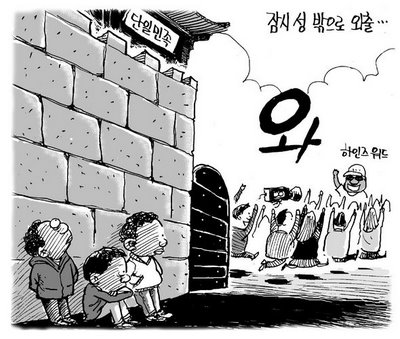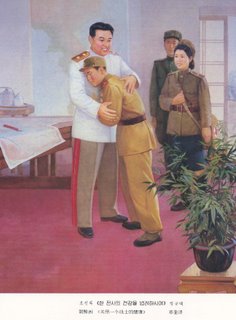Not that the attitude of the official DPRK towards other "races" or towards the idea of other than pure Koreans living in Korea has been in doubt, but a piece in today's "Worker's Daily" (Rodong Sinmun) is a good remainder: "The Idea of a Multinational, Multiracial Society Means Destruction of the Korean Nation" (로동신문 《<다민족,다인종사회>론은 민족말살론》).
The article refers to the "recently appearing bizarre pursuits for a 'multinational, multiracial society' in South Korea, which will weaken (kôsehada) the basic characteristics of our nation (minjok)". (Kôsehada means also "to castrate".) It names, ironically enough (but this is DPRK), the "pro-US flunkeyist forces" as the biggest perpretrators in these heinous acts against the purity of the nation. I just wonder what might be the response to this among the pro-US flunkeyist progressives who have made the grave error of paying attention to the human rights of children from mixed marriages or of foreign workers.
(But this also reminds me of the basic irony and contradiction of a newspaper named "one nation" or "nation as one" having a cartoon criticizing the concept of tanil minjok in context of Hines Ward's visit to Korea and the predicament of mixed kids in Korea.)
I'll reproduce the whole article here for the benefit of visitors from South Korea, where access to KCNA is blocked. (Unfortunately I don't have the time to translate more than a few choice paragraphs, but additional translation contributions are welcome in the comments.)
(Update.
Robert of The Marmot's Hole has translated the whole piece, and also spotted a summary of it in English at KCNA. Please check them instead of my English-as-third-language attempts at translation.) 로동신문 《<다민족,다인종사회>론은 민족말살론》
(평양 4월 27일발 조선중앙통신)27일부 《로동신문》은 《<다민족,다인종사회>론은 민족말살론》이라는 제목으로 된 다음과 같은 개인필명의 론평을 실었다.
최근 남조선에서 우리 민족의 본질적특성을 거세하고 《다민족,다인종사회》화를 추구하는 괴이한 놀음이 벌어지고있다. Recently bizarre pursuits for a 'multinational, multiracial society' are appearing in South Korea, weakening the basic characteristics of our nation.
이 소동의 연출자들은 남조선이 미국인 등 여러 인종의 피가 섞인 《혼혈의 지역》이라느니, 《페쇄적인 민족주의 극복》이니, 미국과 같은 《다민족국가의 포용성과 개방성》이니 하는 황당한 설을 들고나오고있다. The perpetrators of this agitation are presenting strange ideas like "area of mixed blood", "overcoming the close-minded nationalism" or "inclusiveness and openness of a multinatioal country" like United States.
말마디자체도 민족적감정에 칼질하는것이지만 보다 엄중한것은 이 반민족적인 《다민족,다인종사회》론이 벌써 론의단계를 벗어났다는데 있다. 이미 지금까지 《단군의 후손》,《한피줄》,《한겨레》 등을 강조하여온 초등학교,중고등학교교과서에 2009년부터 《다인종,다민족문화》와 관련된 내용을 포함시키며 《국제결혼가정》,《외국인근로자가정》 등의 용어도 《다문화가정》으로 바꾸기로 하였다.
민족적분노를 금할수 없게 하는 말그대로의 망동이 아닐수 없다. This is nothing but agitation which necessarily evokes national wrath.
결론부터 말한다면 남조선의 친미사대매국세력이 운운하는 《다민족,다인종사회》론은 민족의 단일성을 부정하고 남조선을 이민족화,잡탕화,미국화하려는 용납 못할 민족말살론이다. The conclusion of this is that the "multinational, multiracial society" of the South Korean pro-US flunkeyist traitor forces denies the unity of the Korean people (minjok), displaces, muddles, and Americanizes the Korean people, and is an unforgivable idea for national destruction.
민족은 력사적으로 형성된 민족성원들의 사회생활단위이고 운명공동체이며 해당 민족은 다른 민족과 구별되는 특성이 있어 민족으로 존재하는것이다. 사람들의 운명과 사회발전은 민족과 떼여놓고 생각할수 없다. 민족성은 개별적인 사람과 사회발전에서 중요한 무기로 된다. 하기에 모든 민족이 자기의 고유성을 귀중히 여기고 우수성을 부각시키며 그것으로 민족성원들을 각성,단합시키는데 힘을 넣고있다. 《세계화》의 물결이 어지럽게 범람하는 오늘날 그에 대처하여 민족성을 더욱 내세우며 그 보호의 장벽을 쌓으면 쌓았지 스스로 부정하는 나라와 민족은 없다.
지배주의와 식민주의가 약소민족들의 운명을 위협하는 현실에서 우리 단일민족의 고유성과 우수성을 부정하는것은 민족의 정신무장해제를 설교하는 반역행위이다.
《다민족,다인종사회》론을 제창해나서는 남조선의 친미매국세력은 민족관과 사회력사발전에 대한 초보적인 리해조차 없는것은 물론 한쪼박의 민족의 넋도 없는 얼간망둥이들이다.
South Korean pro-US traitors of the nation, proposing the idea of "multinational, multiracial society" are fools who do not have the faintest idea of the national consciousness (minjokkwan) and social and historical development, and are empty of any national spirit.
단일성은 세상 어느 민족에게도 없는 우리 민족의 자랑이며 민족의 영원무궁한 발전과 번영을 위한 투쟁에서 필수적인 단합의 정신적원천으로 된다. 민족의 단일성이 그처럼 귀중하기에 그것을 살리기 위해 우리 겨레가 피와 목숨을 바쳐 장구하고 험난한 통일의 길을 걸어온것이며 지금은 애국의 열정을 다해 6.15통일시대를 가꾸어가고있는것이다. 민족의 단일성을 살려나가지 않는다면 미국의 지배주의책동앞에서 민족도 개개인의 운명도 지켜낼수 없으며 독도령유권주장에 비낀 일본반동들의 재침기도도 막아낼수 없다. 《다민족,다인종사회》론의 반민족성은 바로 민족자체를 부정하고 나라와 민족을 제국주의자들에게 내맡긴다는데 있다.
온 겨레가 힘을 합쳐 갈라진 조국을 통일하고 단일민족의 존엄과 위용을 높이 떨치자고 하는 때에 남조선에서 민족부정론,민족말살론이 나왔다는데 보다 엄중한 문제가 있다. 지금은 북과 남이 60여년간의 분렬을 끝장내고 민족의 구조적인 단일성을 확립해가는 자주통일시대이며 이 시대의 대세는 《우리 민족끼리》이다. 《다민족,다인종사회》론은 이 시대의 기본리념을 거세하는 독소이고 반통일론리이다. 남조선에서 겨레의 지향에 배치되는 반민족론이 제창되는것은 명백히 북과 남을 혈통이 서로 다른 지대로 만들고 6.15통일시대를 가로막으며 민족을 영구분렬시키려는 《한나라당》을 비롯한 친미족속들의 범죄적인 기도와 미국의 배후조종의 결과이다.
남조선에서 제기되는 혼혈인문제에 대해 말한다면 그것은 전적으로 미국의 남조선에 대한 군사적강점의 산물이다. 이러한 비극적현실을 끝장내기 위해 미군철수의 기치를 들지는 못할망정 오히려 그것을 사회화하려 하고있으니 얼마나 쓸개빠진자들인가.
남조선에서 민족적수치와 분노를 금할수 없게 하는 《다민족,다인종사회》론이 공공연히 나돌고 그것을 현실에 적용하려는 움직임이 나오고있는것은 세계를 일극화하려는 미국의 범죄적책동이 얼마나 위험한것인가를 그대로 보여준다.
남조선의 각계각층 인민들은 주체성과 민족성을 저버린 나머지 우리 민족의 혈통마저 흐리게 하고 민족자체를 말살하려는 사대매국세력의 반민족적책동을 단호히 배격하여야 한다.그리고 우리 민족제일주의와 《우리 민족끼리》의 기치를 더욱 높이 들고 민족을 지키고 통일을 이룩하기 위한 애국투쟁에 적극 떨쳐나서야 할것이다.(끝)
And here is also the cartoon that I referred to above:

[One Nation]
A brief outing from the fortress...
Woaaa Hines Ward
Categories: DPRK • minjok |















 I'm really at loss with some of the naming practices of Korean websites, whether newssites or company pages. In the case of a new leftist (or progressive, as you like) net magazine
I'm really at loss with some of the naming practices of Korean websites, whether newssites or company pages. In the case of a new leftist (or progressive, as you like) net magazine